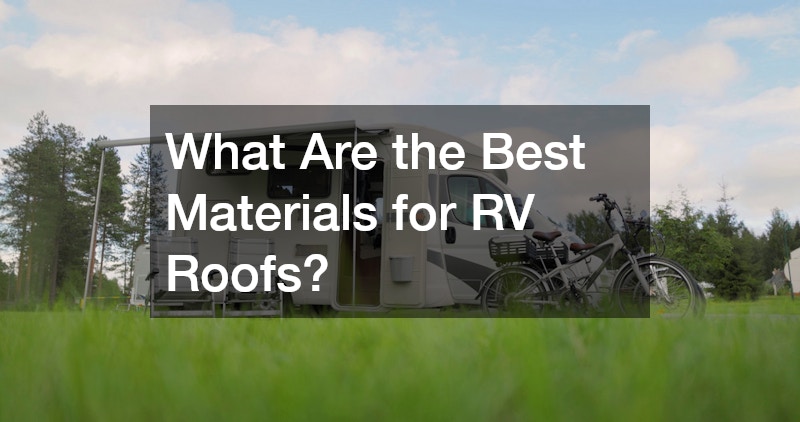
When it comes to maintaining your RV, ensuring that the roof is in top condition is crucial. The roof not only protects the interior from the elements but also significantly affects the overall durability and lifespan of the vehicle. Selecting the best materials for RV roofs is essential for anyone who wants to travel confidently without the stress of leaks or damage from weather conditions. In this article, we will explore various roofing materials available for RVs and assess their pros and cons in terms of longevity, ease of maintenance, and performance.
Video Source
By the end of this guide, you will have a comprehensive understanding of the best RV roof options available to keep your travels smooth and enjoyable.
Rubber roofs, often made from Ethylene Propylene Diene Monomer (EPDM) or Thermoplastic Olefin (TPO), are a popular choice for many RV owners. The flexibility and lightweight nature of rubber make it ideal for a mobile structure that endures various weather conditions. Rubber roofs are also UV-resistant, meaning they won't crack or become brittle when exposed to sunlight over time. Furthermore, the installation of rubber roofing is relatively straightforward, often allowing for DIY projects, which can save money on labor costs. Importantly, proper maintenance can extend the lifespan of rubber roofs, making them a cost-effective solution for long-term RV use.
One significant advantage of rubber roofs is their ability to withstand harsh weather without deteriorating. For instance, EPDM membranes are known for their long-lasting nature, with typical lifespans of up to 20 years with proper care. Furthermore, these materials are resistant to minor punctures and tears, protecting your RV from leaks. Regular cleaning and inspections can go a long way in maintaining the integrity of rubber roofs, ensuring that they remain watertight and safe over the years. Many RV enthusiasts recommend this roofing type due to its admirable performance and low maintenance needs.
Metal roofs, typically made of aluminum or steel, offer remarkable durability and longevity, making them a premium choice among RV owners. The sturdy construction of metal roofs can withstand severe weather—such as heavy snow, rain, and hail—better than many other materials. Moreover, metal surfaces are reflective, providing better thermal efficiency by keeping your RV cooler in hot conditions. This quality reduces the strain on the RV’s air conditioning systems, ultimately saving energy. However, while they are highly durable, there are necessary considerations for maintenance to keep these roofs in pristine condition.
Another benefit of metal roofs is their resistance to fire, mold, and insects, which appeals to safety-conscious travelers. They often come with rust-resistant coatings, which further extend their lifespan and preserve the aesthetic quality of the roof. Proper installation is key to ensuring that a metal roof provides effective protection without leaks, emphasizing the importance of hiring skilled professionals if you opt for this material. Moreover, when considering metal roofs, it’s essential to account for weight distribution, as they are generally heavier than other materials. This might necessitate additional support depending on the structure of the RV.
Fiberglass roofs are another solid choice for RV roofs due to their impressive durability and resistance to weather-related damage. They are constructed in a continuous sheet, which minimizes seams and subsequent leak points, making them a highly watertight option. This seamless construction is appealing for many RV owners, especially those who frequently travel through adverse weather conditions. Moreover, fiberglass roofs don’t require painting, as they come with a finish that can withstand UV exposure far better than other materials. With regular maintenance, fiberglass roofs can potentially last the lifetime of the RV.
Despite their advantages, fiberglass roofs also have their drawbacks. Installation can be more complex than rubber or metal roofs, often requiring professional expertise to ensure proper fitting and sealing. This increased complexity can lead to higher upfront costs as well. Additionally, while they are resistant to cracks and leaks, if they are damaged, repairs can be challenging and expensive, especially if a significant surface area is compromised. Consider these factors when making your overall decision on which type of RV roof will suit your needs best.
Choosing the right material for your RV roof is a decision that can significantly impact your travel experience. With options like rubber, metal, and fiberglass, each material offers unique advantages and potential challenges. It is crucial to assess your travel habits, expected conditions, and maintenance preferences to make an informed choice. By understanding the qualities of each roofing type, you can invest wisely in materials that provide safety, durability, and aesthetic appeal for your RV. Ultimately, ensuring you have the best RV roof option will enhance your adventures and safeguard your investment.
